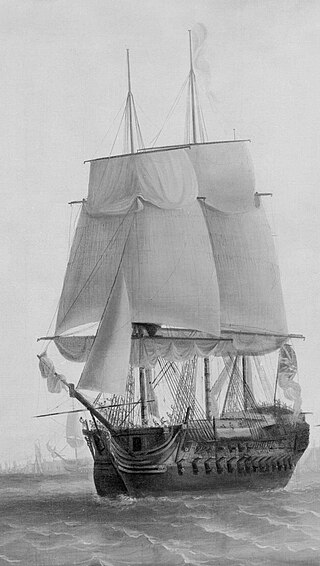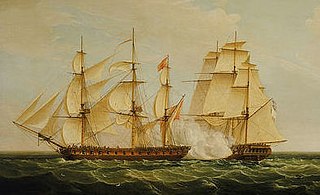
HMS Polyphemus, a 64-gun third-rate ship of the line of the Royal Navy, launched on 27 April 1782 at Sheerness. She participated in the 1801 Battle of Copenhagen, the Battle of Trafalgar, and the Siege of Santo Domingo. In 1813 she became a powder hulk and was broken up in 1827.

Courageux was a 74-gun ship of the line of the French Navy, launched in 1753. She was captured by the Royal Navy in 1761 and taken into service as HMS Courageux. In 1778 she joined the Channel Fleet, and she was later part of the squadron commanded by Commodore Charles Fielding that controversially captured a Dutch convoy on 31 December 1779, in what became known as the Affair of Fielding and Bylandt. On 4 January 1781, Courageux recaptured Minerva in a close-range action west of Ushant that lasted more than an hour. That April, Courageux joined the convoy under George Darby which successfully relieved the Great Siege of Gibraltar.

HMS Lively was a 20-gun post ship of the Royal Navy, launched in 1756. During the Seven Years' War she captured several vessels, most notably the French corvette Valeur in 1760. She then served during the American Revolutionary War, where she helped initiate the Battle of Bunker Hill. The French captured her in 1778, but the British recaptured her in 1781. She was sold in 1784.

HMS St Albans was a 64-gun third rate ship of the line of the Royal Navy, launched on 12 September 1764 by Perry, Wells & Green at their Blackwall Yard, London.

The Foudroyant was an 80-gun ship of the line of the French Navy. She was later captured and served in the Royal Navy as the Third Rate HMS Foudroyant.

Fénix was an 80-gun ship of the line (navio) of the Spanish Navy, built by Pedro de Torres at Havana in accordance with the system laid down by Antonio Gaztaneta launched in 1749. In 1759, she was sent to bring the new king, Carlos III, from Naples to Barcelona. When Spain entered the American Revolutionary War in June 1779, Fénix set sail for the English Channel where she was to join a Franco-Spanish fleet of more than 60 ships of the line under Lieutenant General Luis de Córdova y Córdova. The Armada of 1779 was an invasion force of 40,000 troops with orders to capture the British naval base at Portsmouth.
HMS Meleager was a 32-gun Amazon-class frigate' that Greaves and Nickolson built in 1785 at the Quarry House yard in Frindsbury, Kent, England. She served during the French Revolutionary Wars until 1801, when she was wrecked in the Gulf of Mexico.
HMS Amphitrite was a 24-gun Porcupine-class sixth-rate post ship of the Royal Navy. She served during the American Revolution primarily in the economic war. On the one hand she protected the trade by capturing or assisting at the capture of a number of privateers, some of which the Royal Navy then took into service. On the other hand, she also captured many American merchant vessels, most of them small. Amphitrite was wrecked early in 1794.

HMS Lowestoffe was a 32-gun fifth-rate frigate of the Royal Navy. Built during the latter part of the Seven Years' War, she went on to see action in the American War of Independence and the French Revolutionary War, and served often in the Caribbean. A young Horatio Nelson served aboard her shortly after passing his lieutenant's examination.

HMS Lark was a 16-gun ship sloop of the Cormorant class, launched in 1794 at Northfleet. She served primarily in the Caribbean, where she took a number of prizes, some after quite intensive action. Lark foundered off San Domingo in August 1809, with the loss of her captain and almost all her crew.

HMS Camilla was a Royal Navy 20-gun Sphinx-class post ship. Camilla was built in Chatham Dockyard to a design by John Williams and was launched in 1776. She served in the American Revolution, the French Revolutionary Wars, and the Napoleonic Wars, before being sold in 1831.

John Perkins, nicknamed Jack Punch, was a British Royal Navy officer. Perkins was perhaps the first mixed race commissioned officer in the Royal Navy. He rose from obscurity to be a successful ship's captain in the Georgian Royal Navy. He captained a 10-gun schooner during the American War of Independence and in a two-year period captured at least 315 enemy ships.

Charles Inglis was an officer of the Royal Navy who saw service during the War of the Austrian Succession, the Seven Years' War, and the American War of Independence, rising to the rank of rear-admiral.

HMS Prince William was a 64-gun third-rate ship of the line of the Royal Navy. She had previously been Guipuzcoano, an armed 64-gun ship of the Spanish (Basque) mercantile Guipuzcoan Company of Caracas. She was also known by the religious name of Nuestra Señora de la Asunción.

HMS Surprise was a 28-gun Enterprise-class sixth-rate frigate of the Royal Navy, which served throughout the American Revolutionary War and was broken up in 1783.
Admiral Robert Linzee was an officer of the Royal Navy who served during the American War of Independence, and the French Revolutionary and Napoleonic Wars.
Bunker Hill was a Massachusetts privateer sloop, first commissioned in 1778. She made two cruises, capturing three prizes, but during her second cruise the Royal Navy captured her at Saint Lucia. The Royal Navy took her into service as HMS Surprize. She served in the Caribbean, and was one of the two sloops that captured Essequibo and Demerara in March 1781. She sailed to Britain in late 1782 where the Navy sold her in 1783. The French Navy may have purchased her. If so, they sold her in 1789.

HMS Barbuda was commissioned into the Royal Navy in 1780 after having briefly served as an American privateer. Barbuda was one of the two sloops that captured Demerara and Essequibo in 1781, but the French Navy captured her there in 1782 and took her into service as Barboude. The French Navy sold her to private owners in 1786, and she served briefly as a privateer in early 1793 before the French Navy purchased her again and named her Légère. She served them until mid-1796 when the Royal Navy captured her and took her into service as HMS Legere. She was wrecked off the coast of Colombia, without loss of life, in February 1801.

HMS Pearl was a fifth-rate, 32-gun British Royal Navy frigate of the Niger-class. Launched at Chatham Dockyard in 1762, she served in British North America until January 1773, when she sailed to England for repairs. Returning to North America in March 1776, to fight in the American Revolutionary War, Pearl escorted the transports which landed troops in Kip's Bay that September. Much of the following year was spent on the Delaware River where she took part in the Battle of Red Bank in October. Towards the end of 1777, Pearl joined Vice-Admiral Richard Howe's fleet in Narragansett Bay and was still there when the French fleet arrived and began an attack on British positions. Both fleets were forced to retire due to bad weather and the action was inconclusive. Pearl was then despatched to keep an eye on the French fleet, which had been driven into Boston.
The French brig Duc de Chartres was built between 1779 and 1780 at Le Havre as a 24-gun privateer. As a privateer she captured one British warship before in 1781 the Royal Navy captured her. The Royal Navy took her into service as HMS Duc de Chartres. She then captured several American privateers and armed merchant vessels, and one French naval corvette in a noteworthy single-ship action. The Navy sold Duc de Chartres in 1784.














